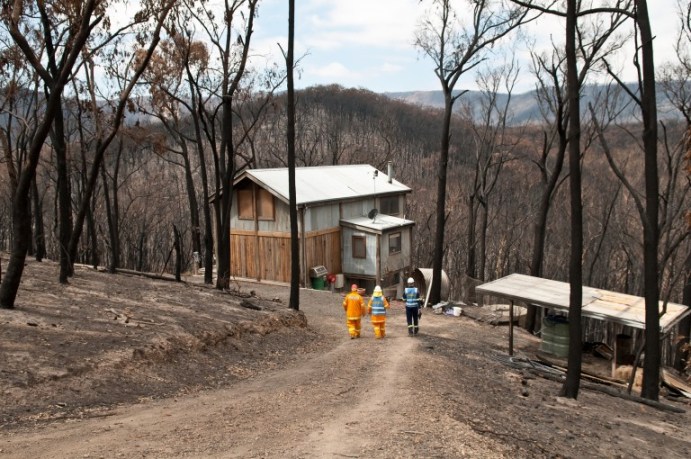
Image: Nick Pitsas, scienceimage.csiro.au
Authored By: Kersten Gentle, CEO of Frame & Truss Manufacturers Association of Australia Ltd (FTMA)
The debate on the “right” materials to use when building homes in bushfire-prone areas often sparks fierce opinions and misguided claims. While some advocate for alternative materials, timber framing remains a viable, safe, reliable and effective option when designed and built in accordance with modern practices. It’s time to set the record straight and address some of the myths that have driven unnecessary fear about building with timber.
One common misconception is that timber frames ignite easily and pose a higher risk of destruction in bushfires compared to steel. However, this oversimplified view ignores the science. Timber-framed houses built in bushfire-prone areas must be designed and constructed in accordance with the Australian Standard AS 3959 Construction of buildings in bushfire-prone areas. AS 3959 provides solutions for timber-framed houses from lower bushfire threats through to an extreme threat referred to as Flame Zone. AS 3959 makes no distinction between using a timber-framed or steel-framed building!
Timber, unlike unprotected steel, remains relatively stable at elevated temperatures. Steel, on the other hand, begins to lose strength and can melt or buckle well before reaching the extreme heat generated by a bushfire if unprotected.
This was seen during the 2009 Black Saturday fires in Victoria and countless other events, where steel was no more invincible than timber, and many steel homes suffered the same fate in the face of ferocious flames.
Another important factor is the role of the surrounding environment. Studies and expert analysis repeatedly confirm that the fuel load around a property—the dry vegetation, debris, and landscape management—is a significant determinant of whether a home survives a bushfire. Building materials alone do not dictate safety. A home surrounded by cleared defensible space and properly managed vegetation is far more likely to survive than a steel-framed house that is overgrown with combustible plants. It’s time we stopped stigmatising timber and started focusing on smarter overall designs and landscape strategies.
What’s more, guidelines for building in bushfire-prone areas—such as using ember guards, managed building sites, and strategic design methodologies—are applicable to all construction types. Timber homes, when constructed to meet the AS 3959 Bushfire Attack Level (BAL) requirements, are every bit as capable as steel or other materials at resisting a bushfire. Claims to the contrary often originate from industries with vested interests, perpetuating myths for commercial gain.
The growing intensity and frequency of fires globally can no longer be ignored, and climate change is a significant driving factor behind this alarming trend. By continuing to rely heavily on materials like steel and concrete, which are produced through energy-intensive processes that emit vast amounts of carbon dioxide, we are exacerbating the very crisis that fuels these catastrophic bushfires.
Conversely, timber offers a sustainable alternative that actively combats climate change by storing carbon throughout its lifecycle. Utilising timber for construction not only reduces our carbon footprint but also aligns with long-term climate action goals. By choosing timber, we are not just building safer, smarter homes in bushfire-prone areas—we are investing in a solution that mitigates the climate crisis and the rising severity of bushfire events it continues to create.
The reality is that no building material, steel included, can stand up to the full force of a catastrophic bushfire fuelled by high winds, extreme temperatures, and towering flames. The Santa Ana winds in California or the blazing infernos wrought by Australia’s Black Summer are clear demonstrations that environmental factors outweigh material choice in the scale of destruction. It is building design, adherence to bushfire construction standards, and proactive land management that provide real solutions—not uninformed material bias.
Timber-framed homes have a place in bushfire-prone areas, and their use should not automatically raise alarm bells. What matters is how we design and build them, as well as how we manage surrounding vegetation and community preparedness. Blanket statements dismissing timber are both scientifically inaccurate and counterproductive. The focus must be on promoting practical, evidence-based strategies instead of politicised fearmongering about building materials.
The way forward for communities in bushfire-prone areas should be based on thoughtful planning, sustainable practices, and respect for fire-smart guidelines. Timber is not the enemy; mismanagement, reckless land practices, and misinformation are. It’s time to embrace timber as part of the solution to combat climate change—not unfairly condemn it as part of the problem.
Our Principal Partners



